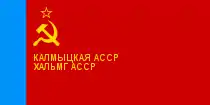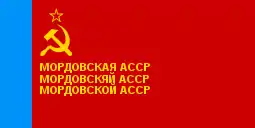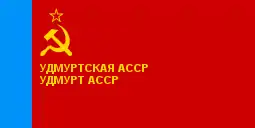Union of Soviet Sovereign Republics
The Union of Soviet Sovereign Republics (Russian: Союз Советских Суверенных Республик (CCCP), romanized: Soyuz Sovetskikh Suverennykh Respublik [SSSR]) was the proposed name of a reorganization of the Union of Soviet Socialist Republics (USSR) into a new confederation. Proposed by the then President of the USSR, Mikhail Gorbachev, the proposal was an attempt to avert an end to the Soviet Union. The proposal was never implemented in the wake of the August Coup in 1991 and the dissolution of the USSR ultimately occurred on December 26 of that year. The overall proposal was resurrected as the Commonwealth of Independent States (CIS), although as a regional organization, not a confederation.

Development
The New Union Treaty (Russian: Новый союзный договор, romanized: Novyy soyuznyy dogovor) was a draft treaty that would have replaced the 1922 Treaty on the Creation of the USSR and thus would have replaced the Soviet Union with a new entity named the Union of Soviet Sovereign Republics, an attempt of Mikhail Gorbachev to salvage and reform the Soviet Union. A ceremony of the Russian SFSR signing the treaty was scheduled for August 20, 1991, but was prevented by the August Coup a day earlier. The preparation of this treaty was known as the Novo-Ogarevo process (новоогаревский процесс), named after Novo-Ogaryovo, a governmental estate where the work on the document was carried out and where Gorbachev talked with leaders of Union republics.
A less centralized federal system was proposed by President Gorbachev during the Communist Party Congress of July 1990. A draft of the New Union Treaty was submitted to the Supreme Soviet of the Soviet Union on November 23, 1990. A drafting committee started work on the text on January 1, 1991. Six of the fifteen Soviet republics, however, did not participate in the drafting of the treaty: Estonia, Latvia, Lithuania, Moldavia, Georgia and Armenia. The proposal was approved by the Soviet of the Union on March 6 and sent to the Supreme Soviets of each republic for approval. Agreement could not be reached on the distribution of power between the Union and the Republics and the proposal was not approved. As an additional restrictive element, some autonomous republics expressed the desire to raise their status and to be a party to the new Soviet treaty.
President Gorbachev tried to gain popular support for the proposal. On March 17, 1991, a popular referendum was held in the nine republics (Russia, Ukraine, Byelorussia, Kazakhstan, Azerbaijan, Uzbekistan, Kirghizia, Turkmenia, and Tajikistan) which participated in the drafting of the treaty. In the referendum 76% of voters supported maintaining the federal system of the Soviet Union, including a majority in all of the nine republics. Opposition was greatest in large cities like Leningrad and Moscow. The referendum was mostly boycotted in the other six republics as they were already moving towards independence.
An agreement between the Soviet central government and the nine republics, the so-called "9+1" agreement, was finally signed in Novo-Ogaryovo on April 23. The New Union Treaty would have converted the Soviet Union into a federation of independent republics with a common president, foreign policy, and military.
By August, eight of the nine republics, except Ukraine, approved the draft of the new Treaty with some conditions. Ukraine did not agree on the terms of the Treaty. In the republican referendum on March 17, the majority of residents of Ukraine supported joining the Union on the terms of Declaration of State Sovereignty of Ukraine.
The treaty stated that jurisdiction over most industries/resources and control over taxation and public expenditures would be turned to those republics that were signing it, and their sovereignties would be recognized, and those which wouldn't sign would be allowed to go their own way. The central government would retain control of the country's armed forces and security services, but with a reduced size and subjected to oversight by the republican legislatives, along with issuing currency, Soviet Rouble and control of its Gold and Diamond resources, although the republics would have the right to share them. The republics and the central government would jointly determine military and foreign policy and work out policies on the economy, fuel, and energy resources. The Congress of People's Deputies would be disbanded. The number of government ministries would be reduced, some ministries having their responsibilities transferred to the republics, some having to reduce staff or abolished, or turned into small co-ordinating bodies which would support republican ministries. The republics would also be given ownership of almost all their natural resources, including mineral deposits on their territories, along with the right to establish direct diplomatic and trade relations with foreign states. A new constitutional court would have also been established to resolve questions between republics and the centre. Lastly, republican law would take precedence over All-Union law.
Though the treaty was intended to save the union, hardliners feared that it would encourage some of the smaller republics to follow the lead of Lithuania and press for full independence. On August 18, the hardliners took control of the government after confining Gorbachev in his Crimean dacha in order to stop him from returning to Moscow to sign the treaty. The August Coup collapsed in the face of overwhelming opposition not only from the smaller republics but from larger ones, especially Russia.
Because the treaty was ultimately never signed at all, even in the aftermath of Ukrainian independence in December, the leaders of republics organized the Commonwealth of Independent States, an alliance of 12 newly independent states (initially all ex-Soviet republics except the Baltic states and Georgia, which joined in 1993, but withdrew again in 2008).
Names
On the first draft of the treaty released in July 1991, the proclaimed name for the new polity was the Union of Soviet Sovereign Republics; Russian: Союз Советских Суверенных Республик, romanized: Soyuz Sovetskikh Suverennykh Respublik.[1] This name was proposed in order to conserve the Russian "СССР" acronym, as well as the "USSR" and "Soviet Union" in English and other languages.
By September 1991, the overall support for preserving the Soviet state changed to reform the Soviet Union into a confederation of sovereign states. The final draft renamed the proposed state the Union of Sovereign States; Russian: Союз Суверенных Государств, romanized: Soyuz Suverennykh Gosudarstv.[2] The overall chances of a continuation of the Soviet system in any form continued to drop and was soon abandoned. Following the August coup, the new union treaty was further reformed into the Commonwealth of Independent States.
Projected member republics and ASSR
.svg.png.webp) Russia
Russia
 Bashkir Soviet Socialist Republic
Bashkir Soviet Socialist Republic Buryat Soviet Socialist Republic
Buryat Soviet Socialist Republic Checheno-Ingush Soviet Socialist Republic
Checheno-Ingush Soviet Socialist Republic Chuvash Soviet Socialist Republic
Chuvash Soviet Socialist Republic Dagestan Soviet Socialist Republic
Dagestan Soviet Socialist Republic Kabardino-Balkar Soviet Socialist Republic
Kabardino-Balkar Soviet Socialist Republic Kalmyk Soviet Socialist Republic
Kalmyk Soviet Socialist Republic Karelo-Finnish Soviet Socialist Republic
Karelo-Finnish Soviet Socialist Republic Komi Soviet Socialist Republic
Komi Soviet Socialist Republic Mari Soviet Socialist Republic
Mari Soviet Socialist Republic Mordovian Soviet Socialist Republic
Mordovian Soviet Socialist Republic North Ossetian Soviet Socialist Republic
North Ossetian Soviet Socialist Republic Tatar Soviet Socialist Republic
Tatar Soviet Socialist Republic.svg.png.webp) Tuvan Soviet Socialist Republic
Tuvan Soviet Socialist Republic Udmurt Soviet Socialist Republic
Udmurt Soviet Socialist Republic Yakut Soviet Socialist Republic
Yakut Soviet Socialist Republic Union of Cossack Republics of Southern Russia[3]
Union of Cossack Republics of Southern Russia[3]
 Ukraine
Ukraine
.svg.png.webp) Byelorussia (Belarus)
Byelorussia (Belarus).svg.png.webp) Azerbaijan
Azerbaijan
 Kazakhstan
Kazakhstan.svg.png.webp) Uzbekistan
Uzbekistan
.svg.png.webp) Turkmenia (Turkmenistan)
Turkmenia (Turkmenistan) Tajikistan
Tajikistan Kirghizia (Kyrgyzstan)
Kirghizia (Kyrgyzstan)
See also
References
- On 20 November 1991 at convened by the Union of Cossacks of Southern Russia, the Great Cossack Circle of Southern Russia in the city of Novocherkassk, it was declared unification of those republics into the Union of Cossack Republics of Southern Russia (SKRYuR) with the capital in the city of Novocherkassk and with status of a union republic in the proposed Union of Sovereign States (SSG). There were established bodies of government power of the Union, created Ambassadorial stanitsa in Moscow, appointed Extraordinary and Plenipotentiary Ambassador of the SKRYuR. The creation of Cossack "republics" was supported by the 2nd Great Circle of the Union of Cossacks of Southern Russia that took place on November 7–10, 1991 in Stavropol. [20 ноября 1991 года, на созванном Союзом казаков Юга России Большом казачьем круге Юга России в г. Новочеркасске, было провозглашено объединение этих республик в Союз Казачьих Республик Юга России (СКРЮР) со столицей в г. Новочеркасске и со статусом союзной республики в предполагавшемся Союзе суверенных государств (ССГ). Были учреждены органы власти Союза, образована Посольская станица в Москве, назначен чрезвычайный и полномочный посол СКРЮР. Создание казачьих «республик» поддержал II Большой Круг Союза казаков Юга России, прошедший 7–10 ноября 1991 в г. Ставрополе.] Cossack Separatism: Contemporary situation (КАЗАЧИЙ СЕПАРАТИЗМ: СОВРЕМЕННОЕ СОСТОЯНИЕ). Scientific Society of Cossack Studies. 5 September 2013
Sources
- The USSR in 1991: The Implosion of a Superpower by Dr. Robert F. Miller, RSSS, ANU.
- 1991 Diplomatic Bluebook, Section 4. The Soviet Union by the Japanese Foreign Ministry.